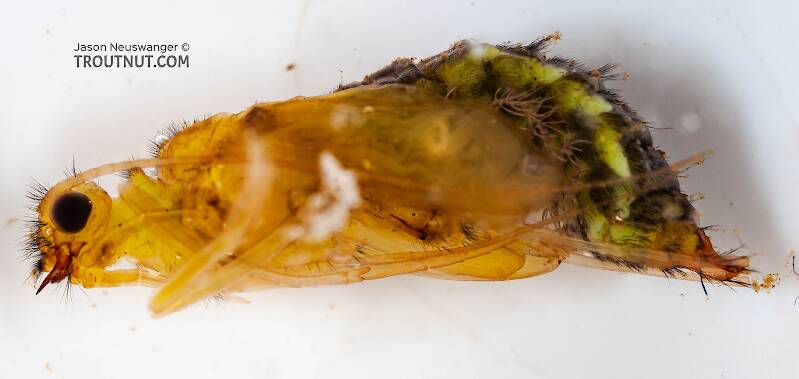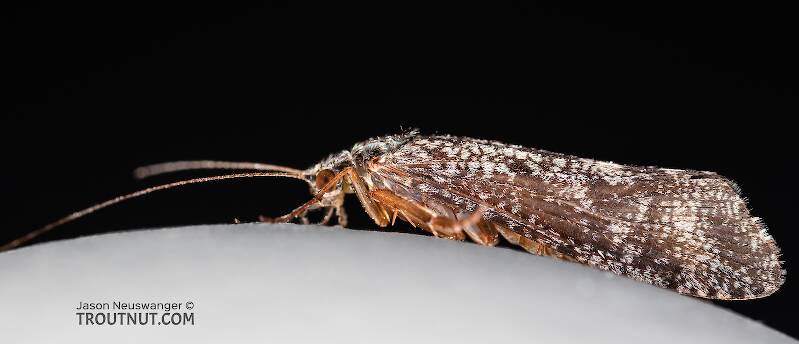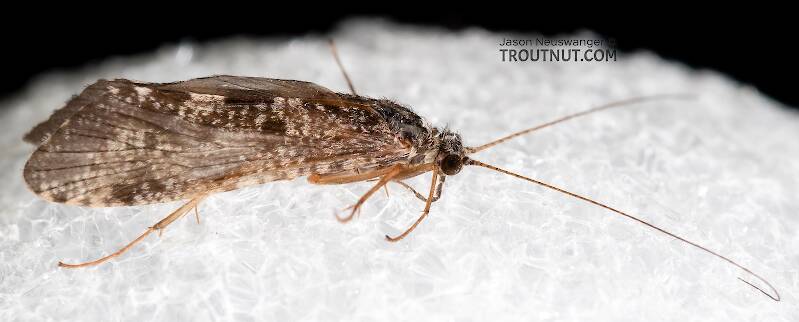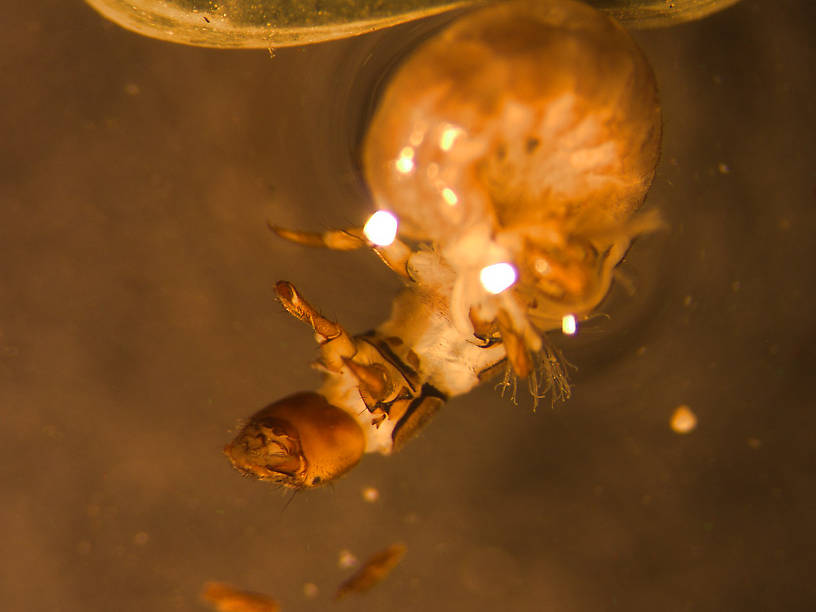
Hex Mayflies
Hexagenia limbata
The famous nocturnal Hex hatch of the Midwest (and a few other lucky locations) stirs to the surface mythically large brown trout that only touch streamers for the rest of the year.
Featured on the forum

It's only barely visible in one of my pictures, but I confirmed under the microscope that this one has a prosternal horn and the antennae are mid-way between the eyes and front of the head capsule.
I'm calling this one Pycnopsyche, but it's a bit perplexing. It seems to key definitively to at least Couplet 8 of the Key to Genera of Limnephilidae Larvae. That narrows it down to three genera, and the case seems wrong for the other two. The case looks right for Pycnopsyche, and it fits one of the key characteristics: "Abdominal sternum II without chloride epithelium and abdominal segment IX with only single seta on each side of dorsal sclerite." However, the characteristic "metanotal sa1 sclerites not fused, although often contiguous" does not seem to fit well. Those sclerites sure look fused to me, although I can make out a thin groove in the touching halves in the anterior half under the microscope. Perhaps this is a regional variation.
The only species of Pycnopsyche documented in Washington state is Pycnopsyche guttifera, and the colors and markings around the head of this specimen seem to match very well a specimen of that species from Massachusetts on Bugguide. So I am placing it in that species for now.
Whatever species this is, I photographed another specimen of seemingly the same species from the same spot a couple months later.
I'm calling this one Pycnopsyche, but it's a bit perplexing. It seems to key definitively to at least Couplet 8 of the Key to Genera of Limnephilidae Larvae. That narrows it down to three genera, and the case seems wrong for the other two. The case looks right for Pycnopsyche, and it fits one of the key characteristics: "Abdominal sternum II without chloride epithelium and abdominal segment IX with only single seta on each side of dorsal sclerite." However, the characteristic "metanotal sa1 sclerites not fused, although often contiguous" does not seem to fit well. Those sclerites sure look fused to me, although I can make out a thin groove in the touching halves in the anterior half under the microscope. Perhaps this is a regional variation.
The only species of Pycnopsyche documented in Washington state is Pycnopsyche guttifera, and the colors and markings around the head of this specimen seem to match very well a specimen of that species from Massachusetts on Bugguide. So I am placing it in that species for now.
Whatever species this is, I photographed another specimen of seemingly the same species from the same spot a couple months later.

Troutnut is a project started in 2003 by salmonid ecologist Jason "Troutnut" Neuswanger to help anglers and
fly tyers unabashedly embrace the entomological side of the sport. Learn more about Troutnut or
support the project for an enhanced experience here.
Caddisfly Genus Hydropsyche (Spotted Sedges)
The most important genus in the most important family of caddis.
More to come - Page in edit mode.
More to come - Page in edit mode.
Where & when
In 1874 records from GBIF, adults of this genus have mostly been collected during June (26%), July (22%), May (17%), August (17%), September (7%), and April (6%).
In 802 records from GBIF, this genus has been collected at elevations ranging from 3 to 13671 ft, with an average (median) of 2723 ft.
Genus Range
Specimens of the Caddisfly Genus Hydropsyche
4 Adults
3 Male Adults
2 Female Adults
1 Pupa

Several users have interesting comments in the discussion of this specimen, but this observation by Creno is especially good:
Also, this is what I would call an "immature" pupa. The wingpads of caddis pupae darken to nearly black as the enclosed adults near emerging. The darkening is the developing adult wing inside the pupal wing pad. The ultimate coloration of the adult wing is not very apparent in most pupal wing pads as the majority of the adult wing coloration comes from the color/position of the adult wing hairs and setae. But dark pupal wingpads are a good indication that the emergence will occur very soon, likely that day or so, and that the adult parts are sufficiently developed within the pupae to make a species determination from the specimen, particularly if it is a male.
3 Larvae
Start a Discussion of Hydropsyche
References
- LaFontaine, Gary. 1981. Caddisflies. The Lyons Press.
- Schwiebert, Ernest G. 1955. Matching the Hatch. MacMillan Publishing Company.
- Swisher, Doug and Carl Richards. 2000. Selective Trout. The Lyons Press.
Caddisfly Genus Hydropsyche (Spotted Sedges)
Taxonomy
Species in Hydropsyche
Hydropsyche aenigma
1
18
Hydropsyche alternans
0
0
Hydropsyche betteni
0
0
Hydropsyche bidens
0
0
Hydropsyche bronta
0
0
Hydropsyche californica
1
5
Hydropsyche cockerelli
0
0
Hydropsyche occidentalis
1
6
Hydropsyche oslari
0
0
Hydropsyche simulans
0
0
Hydropsyche slossonae
0
0
Hydropsyche sparna
0
0
Hydropsyche vexa
0
0
Species in Hydropsyche: Hydropsyche aenigma, Hydropsyche alternans, Hydropsyche betteni, Hydropsyche bidens, Hydropsyche bronta, Hydropsyche californica, Hydropsyche cockerelli, Hydropsyche occidentalis, Hydropsyche oslari, Hydropsyche simulans, Hydropsyche slossonae, Hydropsyche sparna, Hydropsyche vexa
47 species (Hydropsyche aenigma, Hydropsyche aerata, Hydropsyche alabama, Hydropsyche alternans, Hydropsyche alvata, Hydropsyche arinale, Hydropsyche auricolor, Hydropsyche bassi, Hydropsyche bidentata, Hydropsyche bronta, Hydropsyche brunneipennis, Hydropsyche carolina, Hydropsyche catawba, Hydropsyche cockerelli, Hydropsyche confusus, Hydropsyche cuanis, Hydropsyche decalda, Hydropsyche delrio, Hydropsyche demora, Hydropsyche depravata, Hydropsyche dicantha, Hydropsyche elissoma, Hydropsyche fattigi, Hydropsyche franclemonti, Hydropsyche frisoni, Hydropsyche hageni, Hydropsyche hoffmani, Hydropsyche impula, Hydropsyche incommoda, Hydropsyche leonardi, Hydropsyche marqueti, Hydropsyche mississippiensis, Hydropsyche opthalmica, Hydropsyche orris, Hydropsyche patera, Hydropsyche phalerata, Hydropsyche philo, Hydropsyche placoda, Hydropsyche potomacensis, Hydropsyche reciprocus, Hydropsyche reiseni, Hydropsyche rossi, Hydropsyche rotosa, Hydropsyche scalaris, Hydropsyche valanis, Hydropsyche venularis, and Hydropsyche winema) aren't included.













